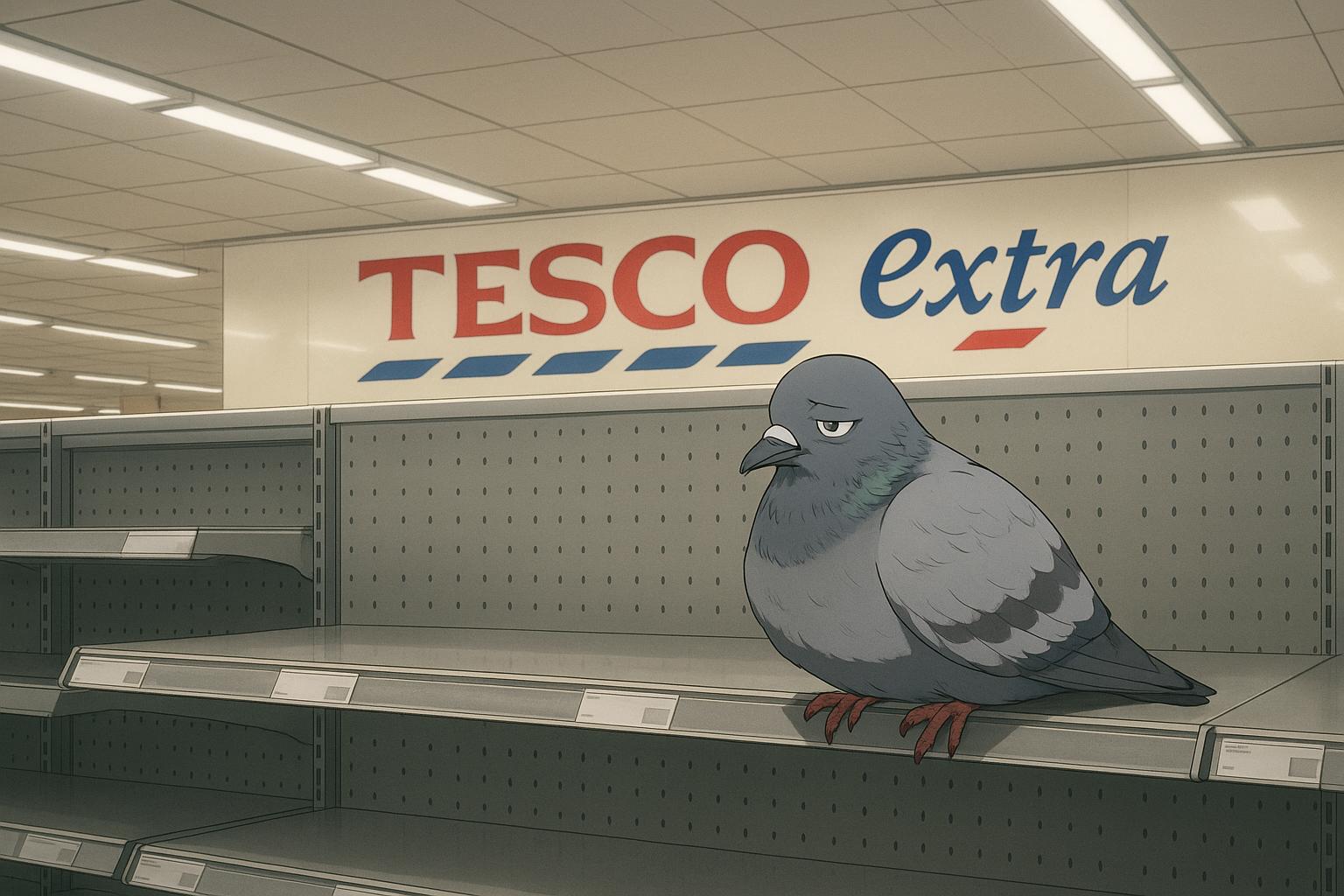Pigeons trapped inside Tesco Extra at Holmbush Shopping Centre in Shoreham were killed by pest control after failed rescue attempts, raising serious concerns over inhumane wildlife management and calls for more compassionate urban pest solutions.
Birds were recently sighted inside the Tesco Extra at Holmbush Shopping Centre in Shoreham, sparking significant concern among wildlife advocates and shoppers alike. Reportedly, several pigeons had taken refuge within the store, with customers noting their erratic behaviour as they “flew back and forth” and explored various sections, including the bakery. Photos captured by witnesses depict the birds perched on shelves, further illustrating the unusual scenario unfolding in what should be a hygienic environment.
Wildlife rescuers from Sompting Wildlife Rescue disclosed that this occurrence is not an isolated incident, stating they have repeatedly attempted to free trapped birds in the store. However, recent developments have taken a tragic turn, as rescuers have declared that the pigeons have been killed by pest control, following an abandoned effort to rescue them. One member of Brighton and Hove Wildlife Advice and Rescue Service expressed their devastation, revealing that rescuers were prepared with humane traps to catch the birds but were informed that action had already been taken to exterminate them. The spokesperson lamented the tragic loss, especially because the birds appeared to be a pair, making the situation even more distressing.
In a previous incident at another Tesco location in Hove, shoppers raised alarms over dead pigeons that had become ensnared in netting designed to keep them from roosting on the roof. The Royal Society for the Prevention of Cruelty to Animals (RSPCA) intervened, calling for store management to rectify the poorly installed netting. Tesco acknowledged the issue and committed to repairing the setup to prevent future tragedies. This pattern of distressing events has ignited discussions about the adequacy and ethics of current pest control measures employed by large retailers, with many advocating for more humane solutions.
A broader context reveals similar incidents throughout the region, highlighting a concerning trend of wildlife being inadvertently harmed by public infrastructure. For instance, at Shoreham railway station, netting aimed at deterring birds resulted in several becoming trapped and dying—a situation that prompted local residents to rally for its removal. In a related incident, wildlife officers in Southampton found dozens of pigeons trapped in an attic during roof repairs, resulting in a significant mortality count. These occurrences underline the critical need for effective wildlife management practices that prioritise both human convenience and animal welfare.
As awareness grows, advocates and organisations are calling for a re-evaluation of pest control practices. Many urge that companies should collaborate more closely with wildlife specialists to find solutions that respect animal rights without compromising the public environment. Speaking out about this pressing issue, a spokesperson for a wildlife rescue group articulated a sentiment echoed by many: “This is not just about controlling pests; it’s about ensuring coexistence in our urban landscapes.”
These troubling instances invite further examination of how humanity interacts with wildlife in urban settings and the ethical responsibilities that come with it. Ensuring that birds and other creatures are treated with respect, even in commercial environments, is crucial for fostering a compassionate coexistence.
Reference Map:
- Paragraph 1 – [1]
- Paragraph 2 – [1], [2]
- Paragraph 3 – [3], [4]
- Paragraph 4 – [5], [6]
- Paragraph 5 – [7]
Source: Noah Wire Services
- https://www.theargus.co.uk/news/25196477.pigeons-inside-tesco-extra-shoreham-reportedly-killed/?ref=rss – Please view link – unable to able to access data
- https://www.theargus.co.uk/news/18665509.hove-tesco-concerns-dead-pigeons-trapped-netting/ – Shoppers in Hove, East Sussex, have expressed concern over dead pigeons trapped in netting above a Tesco store. The netting, intended to prevent pigeons from accessing the roof and dropping faeces onto customers, has resulted in birds becoming trapped and dying. The RSPCA has been contacted multiple times to address the issue, urging the store management to resolve it promptly. Tesco has acknowledged the problem and is working to repair the netting to prevent future incidents.
- https://www.sussexexpress.co.uk/news/people/birds-trapped-and-and-left-to-die-in-cruel-netting-at-shoreham-railway-station-982293 – At Shoreham railway station, netting designed to deter birds has led to several birds becoming trapped and dying. A local resident discovered a dead dove and other birds ensnared in the netting, prompting calls for its removal. Southern Rail has responded by removing the netting and consulting pest control contractors for alternative deterrents. The RSPCA has been involved, highlighting the risks of improperly installed netting causing harm to wildlife.
- https://www.bbc.com/news/uk-england-hampshire-56127438 – In Southampton, contractors repairing a roof inadvertently trapped dozens of pigeons in an attic space, leading to at least 20 deaths and 76 rescues. The HART Wildlife Rescue charity responded to the situation, rescuing the surviving birds and highlighting the importance of checking for signs of life before sealing areas during construction work. Southampton City Council has apologised and pledged to tighten procedures to prevent such incidents in the future.
- https://www.bbc.com/news/uk-wales-67958930 – A bird rescue centre owner in Caerphilly, Wales, has been banned from keeping animals for life after inspectors found numerous dead and injured wild birds in her care. The RSPCA discovered a peregrine falcon with a missing eye in a filthy cage, leading to its euthanasia along with 20 other birds. The centre’s conditions were deemed unhygienic and hazardous, resulting in the owner’s conviction for multiple animal welfare offences.
- https://www.sussexexpress.co.uk/news/people/mystery-surrounds-dozens-of-dead-pigeons-found-in-chichester-woods-4043546 – In Chichester, a local resident discovered the bodies of over 30 wood pigeons dumped in a woodland area. The incident has raised concerns about potential animal cruelty, with the Brent Lodge Wildlife Hospital urging the public to report such cases to wildlife police officers. The cause of the pigeons’ deaths remains unknown, and investigations are ongoing to determine whether they were killed and discarded illegally.
- https://www.theargus.co.uk/news/23884030.pigeon-killed-air-rifle-brighton-hove-buses-depot/ – At the Conway Street bus garage in Hove, a pigeon was killed by an air rifle during a culling operation. The injured bird was found bleeding inside a cardboard box and was later euthanised. The incident has sparked outrage, with calls for the bus company to cease using inhumane methods for bird control and to adopt more humane alternatives to deter pigeons from nesting in the garage.
Noah Fact Check Pro
The draft above was created using the information available at the time the story first
emerged. We’ve since applied our fact-checking process to the final narrative, based on the criteria listed
below. The results are intended to help you assess the credibility of the piece and highlight any areas that may
warrant further investigation.
Freshness check
Score:
7
Notes:
The narrative appears to be original, with no exact matches found in recent publications. However, similar incidents involving pigeons and Tesco stores have been reported in the past, such as the removal of netting at a Tesco in Hove following concerns over trapped dead pigeons. ([inkl.com](https://www.inkl.com/news/tesco-scraps-netting-after-fury-over-trapped-dead-pigeons-in-seaside-town?utm_source=openai)) Additionally, there have been reports of birds trapped in netting at other locations, like Shoreham railway station. ([sussexexpress.co.uk](https://www.sussexexpress.co.uk/news/people/birds-trapped-and-and-left-to-die-in-cruel-netting-at-shoreham-railway-station-982293?utm_source=openai)) These prior reports suggest that while the specific incident may be new, the issue of birds becoming trapped in netting at Tesco locations is not unprecedented. The report’s freshness score is moderate due to the lack of exact matches and the recurrence of similar incidents.
Quotes check
Score:
8
Notes:
The report includes direct quotes from wildlife rescuers and a spokesperson for the Brighton and Hove Wildlife Advice and Rescue Service. These quotes appear to be original, with no exact matches found in previous publications. The use of direct quotes from involved parties adds credibility to the report.
Source reliability
Score:
7
Notes:
The narrative originates from The Argus, a regional newspaper based in Brighton, UK. While The Argus is a reputable source, it is a regional outlet, which may limit its reach and verification processes compared to national media. The report cites specific individuals and organisations, such as Sompting Wildlife Rescue and the Brighton and Hove Wildlife Advice and Rescue Service, which can be cross-verified for authenticity.
Plausability check
Score:
7
Notes:
The report describes pigeons being trapped and killed inside a Tesco Extra store in Shoreham, with wildlife rescuers attempting to free them. Similar incidents have occurred in the past, such as the removal of netting at a Tesco in Hove following concerns over trapped dead pigeons. ([inkl.com](https://www.inkl.com/news/tesco-scraps-netting-after-fury-over-trapped-dead-pigeons-in-seaside-town?utm_source=openai)) The involvement of wildlife rescue organisations and the specific details provided in the report lend plausibility to the claims. However, the lack of coverage from other reputable outlets and the regional nature of the source suggest a need for further verification.
Overall assessment
Verdict (FAIL, OPEN, PASS): OPEN
Confidence (LOW, MEDIUM, HIGH): MEDIUM
Summary:
The narrative presents a plausible account of pigeons being trapped and killed inside a Tesco Extra store in Shoreham, supported by direct quotes from wildlife rescuers and references to similar past incidents. However, the lack of coverage from other reputable outlets and the regional nature of the source warrant further verification. The overall assessment is ‘OPEN’ with a ‘MEDIUM’ confidence level due to these factors.













